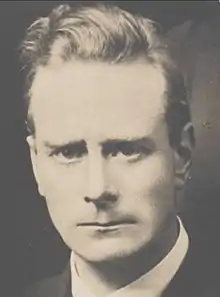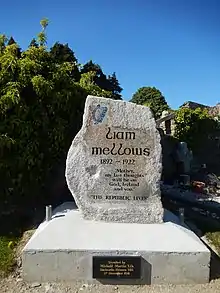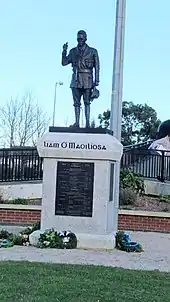Liam Mellows
Liam (William Joseph) Mellows (Irish: Liam Ó Maoilíosa,[1][2] 25 May 1892 – 8 December 1922; surname often misspelled as Mellowes) was an Irish republican and Sinn Féin politician.[3] Born in England, to a British Army father, Mellows grew up in Ashton-under-Lyne, Dublin, Cork and Wexford (where his mother was born). He was active with the Irish Republican Brotherhood and Irish Volunteers, and participated in the Easter Rising in County Galway, and the War of Independence. Elected as a TD to the First Dáil, he rejected the Anglo-Irish Treaty and was captured by pro-Treaty forces during the Irish Civil War. Mellows was executed by Free State forces in 1922.
Liam Mellows | |
|---|---|
 | |
| Teachta Dála | |
| In office December 1918 – May 1921 | |
| Constituency | Both East Galway and North Meath |
| Personal details | |
| Born | 25 May 1892 Ashton-under-Lyne, Lancashire, England |
| Died | 9 December 1922 (aged 30) Mountjoy Gaol, Phibsborough, Dublin, Ireland |
| Political party | Sinn Féin |
| Military service | |
| Branch/service | Anti-Treaty IRA |
| Battles/wars | Easter Rising Irish War of Independence Irish Civil War |
Career
Early life
Mellows was born at Hartshead Military Barracks, Ashton-under-Lyne, Lancashire, England, to William Joseph Mellows, a British Army non-commissioned officer, and Sarah Jordan, of Inch, County Wexford,.[4] His family moved to 10 Annadale Avenue, Fairview, Dublin, in February 1895 when Sergeant Mellows was transferred there; however, Liam remained in Wexford with his grandfather Patrick Jordan due to ill health. He attended the military school in Wellington Barracks in Cork and the Portobello garrison school in Dublin, but ultimately refused a military career much to his father's disappointment, instead working as a clerk in several Dublin firms, including the Junior Army & Navy Stores on D'Olier Street.
Entry into politics
A nationalist from an early age. He purchased a bicycle when resident at 21 Mont Shannon Road, Dublin. Then in 1911 he purchased a copy of Irish Freedom, which began We stand for Ireland.... Mellows approached Thomas Clarke in his shop, who recruited him into Fianna Éireann,[5] an organisation of young republicans. He also met Secretary Patrick O'Ryan, Con Colbert, Eamon Martin, who would be a lifetime friend. At the next meeting, Mellows' brothers all signed up. On 7 April 1911 he was sworn to secrecy by the Irish Republican Brotherhood. Mellows was proposed for the post of Organiser and travelling instructor. He founded the Sluagh[6] at Dolphins Barn, Co Wexford, which was a success. He established more Sluagdste at Ferns and Enniscorthy in Easter 1912. Mellows cycled everywhere, which was cheap and convenient; he was promoted Captain by Ard Choisde.[7] In June 1913, Mellows stayed at Waterford IRB Centre with Liam Walsh in the Gaelic League Room, Williams street.

Mellows was organising sports in Tuam, September 1913, when he was introduced to socialist James Connolly at Countess Markievicz's residence, where Connolly was recuperating after his hunger strike. Connolly was deeply impressed and told his daughter Nora 'I have found a real man'. Mellows was called back to Dublin on 25 November 1913. He was active in the IRB and was a founder member of the Irish Volunteers, being brought onto its Organising Committee to strengthen the Fianna representation. He was given a full-time job on 30 s. p/wk. He joined forces with Éamonn Ceannt and Sir Horace Plunkett at the Provisional Committee choosing to support the parliamentary route taken by Roger Casement. But as an employee he was compelled to agree with Redmondite candidates; although he had voted against the Nationalists pro-British policy.
He was arrested and jailed on several occasions under the Defence of the Realm Act. On 1 August his company were taking an arms shipment from Howth to Dublin, when they fired on RIC at Clontarf. That evening De Valera took him by car to Kilcoole. Guns were loaded on a charabanc in Bray at night and then distributed in Dublin from a fleet of taxis. He was sent to Galway, and made his base at Athenry. There he met Seán Mac Diarmada and was appointed as election scrutineer at Tuam. On Sunday 18 May 1915, they were at an anti-enlistment rally, when arrested by Inspector Comerford with a gun in his back. Mac Diarmada was searched: they found a note book of IRB lists on his person. He was sentenced to 6 months. Mellows got away. He started a training group at Kynoch's Fort, south Galway recruiting men from miles around. On 1 July he was arrested at Courttown Harbour. He was sentenced to 3 months. Both men were sent to Mountjoy Prison. Months later he was with volunteers at Tullamore, when they were attacked by machine-guns, and fleeing the Hall over rooftops, made off by motor-bike; Mellows returned to post a letter to protect comrades. A week later he was arrested at Julia Morrissey's house. The British took him by train to Arbour Hill Prison, before he was shipped to England, and Leek.
1916 Easter Rising
Eventually escaping from Reading Jail he returned to Ireland to command the "Western Division" (forces operating in the West of Ireland) of the IRA during the Easter Rising of 1916. He led roughly 700 Volunteers in abortive attacks on Royal Irish Constabulary stations at Oranmore, and Clarinbridge in county Galway taking over the town of Athenry. However, his men were very badly armed and supplied and they dispersed after a week, when British troops and the cruiser Gloucester were sent west to attack them. In the aftermath of the Uprising over three hundred Galway Volunteers were deported to jails across England and Scotland.
After this insurrection failed, Mellows escaped to the United States, where he was arrested and detained without trial in the "Tombs" prison, New York, on a charge of attempting to aid the German side in the First World War. This was in the context of incidents like the Black Tom and Kingsland explosions, where German agents had bombed neutral American ports and industrial facilities.
After his release in 1918, he worked with John Devoy and helped to organise Éamon de Valera's fund raising visit to America in 1919–1920. He returned to Ireland to become Irish Republican Army "Director of Supplies" during the Irish War of Independence, responsible for buying arms. At the 1918 general election, he was elected to the First Dáil as a Sinn Féin candidate for both Galway East and for North Meath.[8] (According to United Kingdom law, these were Westminster constituencies but Sinn Féin did not recognise them as such, but rather took them as de facto Dáil constituencies).
Opponent of the Treaty
Mellows considered the Anglo-Irish Treaty as signed to be a betrayal of the Irish Republic, saying, in the Treaty Debates of 1921–22:
We do not seek to make this country a materially great country at the expense of its honour in any way whatsoever. We would rather have this country poor and indigent, we would rather have the people of Ireland eking out a poor existence on the soil; as long as they possessed their souls, their minds, and their honour. This fight has been for something more than the fleshpots of Empire.
A conference of nine TDs was deputed to meet privately on 5 January 1922 to resolve the dispute and to achieve a unified front by compromise. The four other anti-Treaty TDs said there was agreement but Mellows did not, and was seen thereafter by pro-Treaty TDs as one of their most implacable opponents.[9] The following day the Dáil voted to approve the Treaty by a majority of 64 to 57. Details on the private conference and the private Dáil session debate were not made public until the 1970s.
He wrote a social programme based on the Dáil's Democratic Programme of 1919 aimed at winning popular support for the anti-Treaty cause.[10]
Civil war
Mellows was one of the more strident TDs on the approach to the Irish Civil War. On 28 April 1922 he told the Dáil:
"There would no question of civil war here now were it not for the undermining of the Republic. The Republic has been deserted by those who state they still intend to work for a Republic. The Volunteers can have very little faith at this moment in the Government that assembles here, because all they can see in it is a chameleon Government. One moment, when they look at it, it is the green, white and orange of the Republic, and at another moment, when they look at it, it is the red, white and blue of the British Empire. We in the Army, who have taken this step, have been termed “mutineers,” “irregulars,” and so forth. We are not mutineers, because we have remained loyal to our trust. We are not mutineers except against the British Government in this country. We may be “irregular” in the sense that funds are not forthcoming to maintain us, but we were always like that and it is no disgrace to be called “irregulars” in that sense. We are not wild people."[11]
In June 1922, he and fellow republicans Rory O'Connor, Joe McKelvey and Richard Barrett, (among others) entered the Four Courts, which had been occupied by anti-Treaty forces since April. However, they were bombarded by pro-Treaty Free State forces and surrendered after two days. Mellows had a chance to escape along with Ernie O'Malley, but did not take it. (See also Battle of Dublin).
Imprisoned in Mountjoy Gaol, Mellows, O'Connor, McKelvey and Barrett were executed by firing squad on 8 December 1922, in reprisal for the shooting of TD Seán Hales (see Executions during the Irish Civil War). These executions and their effects on their fellow prisoners are described in Peadar O'Donnell's Irish Civil War memoir, The Gates Flew Open.[12]
Ideology
In 1922 The Irish Labour Party posthumously published a document entitled "Liam Mellow's Jail Programme", based on notes Mellows had smuggled out of jail after being captured by the Irish Free State. In this document, Mellows outlines a 10 point programme he proposed that the Anti-Treaty IRA adopt in 1922:[13]
- Ownership and control of all heavy industries by the state for the benefit of all the people
- Complete ownership of the transport system by the state
- State ownership of all banks
- Confiscation of all the large ranches and estates, without compensation to the landed aristocracy, and the distribution of the land among the landless farmers and agricultural labourers. Election of joint councils representatives of these two classes to distribute and manage the land. Abolition of all forms of tenure and indebtedness either to private owners or to the state. Cancellation of all debts and mortgages.
- Establishment of an all-around shorter working day
- Control of workshop conditions, to be vested in a joint council representing the workers' Trade Unions concerned and the state
- Municipalisation of all public services: Trams, light, heat, water, etc and free use by the workers
- Compulsory rationing of all available household accommodation and the abolishing of all rents
- Full maintenance for the unemployed at full Trade Union rates until useful work at Trade Union rates of wages can be provided
- The universal arming of all workers in the town and country to defend their rights[13]
Writing for An Phoblacht in January 2010, Sinn Fein's Eoin O'Broin also discussed Mellows' Marxist political positions. In the article, O'Broin quotes Mellows' "Jail notes", in which Mellows' applies Marxist theory to Ireland and advocates for a "People's Republic". O'Broin concludes the article by suggesting that Sinn Féin should take up these positions.[14]
Commemoration

Mellows is commemorated by statues in Eyre Square in Galway, in the official name of the Irish Defence Forces army barracks at Renmore (Dún Úi Maoilíosa) and in the naming of Mellows Bridge in Dublin. He is also commemorated in the names of two GAA clubs (one in Galway, and Castletown Liam Mellows GAA Club [15] in Wexford), and by Unidare RFC in Ballymun and their "Liam Mellows Perpetual Cup".[16]
Mellows is buried in Castletown cemetery, County Wexford, a few miles from Arklow. An annual commemoration ceremony is held at his grave site, in which a wreath is laid by a member of the Liam Mellows Commemoration committee. "Liam Mellows Avenue" in Arklow is named in his honour, as is "Liam Mellows Street" in Tuam, County Galway, "Liam Mellows Park" in Renmore, Galway and Wexford town, and Mellowes (sic) Road in Finglas, Dublin.
In 2016, Fianna Fáil leader Micheál Martin TD unveiled a new gravestone for Mellows.[17]
In December 2019, a memorial statue was unveiled in Finglas, Dublin.
 Liam Mellows memorial unveiled in 2019
Liam Mellows memorial unveiled in 2019.pdf.jpg.webp) British Army military intelligence file for William Mellowes
British Army military intelligence file for William Mellowes
References
- "Ó hUALLACHÁIN, Colmán (1922–1979)". ainm.ie. Retrieved 29 September 2019.
- "Liam Mellows". Retrieved 29 September 2019.
- "Liam Mellows". Oireachtas Members Database. Retrieved 8 March 2012.
- Irish Independent, 2 December 1952.
- translates as "Soldiers of Ireland"
- translated as "Pack" or crowd.
- translated as "High Committee"
- "Liam Mellows". ElectionsIreland.org. Retrieved 8 March 2012.
- Private Dáil session on 6 January 1922 Archived 7 June 2011 at the Wayback Machine
- Ó Broin, Eoin (2009). Sinn Féin and The Politics of Left Republicanism. Pluto Press. pp. 124-125. ISBN 978-0745324623.
- Dáil Éireann – Volume 2 – 28 April, 1922 – DEPARTMENT OF DEFENCE. Archived 23 October 2007 at the Wayback Machine at www.oireachtas-debates.gov.ie:80
- O’Donnell, Peadar The Gates Flew Open (1932) Ch. 13-15
- Mellows, Liam (1922). "Liam Mellows' Jail Programme". catalogue.nli.ie. Irish Labour Party. Retrieved 28 September 2019.
 This article incorporates text from this source, which is in the public domain.
This article incorporates text from this source, which is in the public domain. - O'Broin, Eoin (January 2010). "Liam Mellows' Republic". sinnfeinkeepleft.blogspot.com. An Phoblacht. Retrieved 28 September 2019.
- "Archived copy". Archived from the original on 2 April 2015. Retrieved 27 February 2020.CS1 maint: archived copy as title (link)
- PM, 12 September 2008 12:00. "Inaugural Finglas blitz". Herald.ie. Retrieved 29 September 2019.
- "New monument to Liam Mellows is unveiled". Independent.ie. Retrieved 29 September 2019.
Further reading
- Conor McNamara, 'Liam Mellows, Soldier of the Irish Republic, Selected Writings 1914-22' (Irish Academic Press, 2019).
- Greaves, C. Desmond. 2004 [New edition]. Liam Mellows and the Irish Revolution. Belfast: Foilseacháin an Ghlór Gafa. ISBN 1-905007-01-9.
- Dáil Treaty Debates
- Photo of Mellowes 1922
- 'Fleshpots of Empire' speech (see above) 4 January 1922
External links
- 1911 census return
- 1901 census return
- . . Dublin: Alexander Thom and Son Ltd. 1923. p. – via Wikisource.
- Liam Mellows, DP10200 in Ireland's Military Service Pensions Collection
| Parliament of the United Kingdom | ||
|---|---|---|
| Preceded by Patrick White James Cosgrave |
Sinn Féin MP for Meath North and Galway East 1918–1922 |
Succeeded by Constituencies abolished |
| Oireachtas | ||
| New constituency | Sinn Féin TD for Meath North and Galway East 1918–1921 |
Succeeded by Constituencies abolished |
| New constituency | Sinn Féin TD for Galway 1921–1922 |
Succeeded by Thomas J. O'Connell |